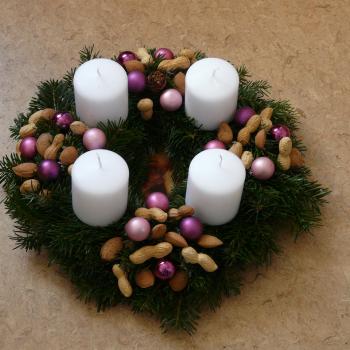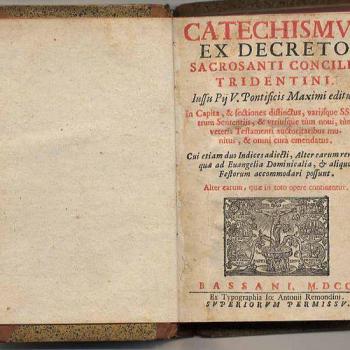This is a guest post by Laurel Whitworth at Aquinas and More.
It’s drawing nearer, that time when we climb up to our dusty attics and seek out stacks of repurposed moving boxes marked “Christmas.” Out come the wreaths and garlands, the endless strings of tangled lights, the plastic lawn ornaments and light-up deer, and maybe even an occasional inflatable Grinch. If you’re lucky, among the tinsel and baubles, you’ll find a beautiful Advent calendar. Beyond the chocolate-a-day tradition, what is Advent? Why do we celebrate this particular season? And where did the tradition of the Advent calendar come from?
Advent: The Meaning of the Word
The word “advent” literally means “the arrival of a notable person, thing, or event.” Advent—which spans most of December—is a time of waiting and preparation for the second coming of Christ. This waiting is observed from three different perspectives. The first is the coming of Christ in the flesh at the Nativity. The second is his arrival in our hearts. The third is his arrival in glory at the end of time. Advent is a time when the devout openly share in the longing for the Second Coming.
When Advent Began
It’s unclear when Advent first began, though it’s believed that it’s been in existence since about 480. Records indicate that monks were ordered to fast every day in December around 567, though some say Saint Peter founded it. That said, it’s impossible to place an exact date of when the tradition was established. Some sources indicate that Advent was started by Bishop Perpetuus in the fifth century, beginning with the feast of Saint Martin. Therefore, Advent is also known as Lent of Saint Martin. In the fifth and sixth centuries, starting on November 11th, worshippers would fast three times per week until the coming of Christmas. In 581, France adopted the practice, and some of the most pious of believers went above and beyond the three-day-per-week requirement and fasted every day of Advent.
What Is the Difference Between Advent and Lent?
The early practices of Advent and Lent are so similar that it’s hard to differentiate between the two. Because early Advent tradition included fasting and was referred to as the Lent of Saint Martin, the Second Vatican Council emphasized the differences in the spirit of both traditions in 1963, noting that Advent is a season of the hope of Christ’s Second Coming.
The Wreath
There are a handful of observed traditions during the Advent season, from liturgical colors to music and decorations. As a matter of fact, one of our most common Christmas decorations originates from the Advent season. The Advent wreath was a concept originated by 16th Century German Lutherans, but it took nearly three centuries for the modern Advent wreath to come about. The Advent wreath we know today is surrounded by candles which represent each celebrated Sunday of the season. German Pastor Johann Hinrich Wichern is behind the concept when, in 1839, he proposed that the lighting of wreath candles would teach children patience as they eagerly awaited the coming of Christmas.
The wreath is traditionally made of fir branches dotted with pine cones, laurel, holly, and mistletoe, and decorated with a red ribbon. The shape of the wreath, like that of a crown, represents victory. The four candles along the outside of the wreath represent the four Sundays before Christmas, the four cardinal virtues—prudence, justice, temperance, and fortitude, as well as the four seasons of the year. The fir tree symbolizes strength, and its green color represents hope. Laurel is a sign of victory over sin, and, because neither it nor holly drops its leaves, this represents the eternity of God. In early days, the Advent wreath was kept on a table in the center of the house for all to enjoy, and many households still uphold this tradition.
Liturgical Colors
Violet is the traditional liturgical color of Advent, though some Christian denominations use blue. Gaudete Sunday is the third Sunday of Advent, so called because “gaudete” is the Latin word for “rejoice.” On this day, purple, which is also the color for penance, is replaced by rose. Rose is a color representing joy, and it takes precedent over purple when the otherwise somber mood of Advent is overridden by the joyous anticipation of the Lord’s Second Coming.
The Four Sundays
Each Sunday of Advent represents a different theme. The first, known as Advent Sunday, represents the anticipation of the Second Coming. The Second Sunday recalls the teachings of John the Baptist, who speaks of preparing the way of the Lord. The Third Sunday, Gaudete Sunday, represents the joy of the second coming of Christ. The Fourth Sunday involves readings of Mary and Joseph and the birth of Jesus. Sundays during Advent should not be given to fasting, but instead to celebration, because we celebrate the resurrection of Our Lord each Sunday.
The Advent Calendar
The Advent calendar was introduced in the 19th and 20th centuries by German Lutherans and has now become a beloved tradition of the Christmas season. The calendar is used to count down the days until Christmas and traditionally features a manger scene and, sometimes, Saint Nicholas. Calendars take many forms, from traditional to modern, but the most popular ones feature small doors—one for each day of December up until Christmas Day. The cubbies behind these doors hold a small gift—either a trinket or a candy. This, like the lighting of the four Advent wreath candles, both satisfies and heightens the anticipation of children awaiting the coming of Christmas morning.
Celebrating Around the World
The most popular way to celebrate Advent is by both lighting wreath candles each Sunday as well as keeping an Advent calendar at home, but there are a few lesser-known traditions as well. In Italy, bagpipe players play in front of the shrines of Mary during the last days of Advent. It’s traditionally believed shepherds played bagpipes at the manger in Bethlehem, paying homage to baby Jesus.
No longer observed for obvious reasons, in Normandy farmers would send children running through the fields while wielding torches. Kids would set fire to piles of straw to drive out vermin, representative of driving out sin from worshippers’ hearts. In England, the custom was for the poor women of the region to carry around dolls representing both Jesus and Mary. Anyone who witnessed them was required to give the women a halfpenny. If they refused, it was said that bad luck would fall upon the household.
Most recently, the residents of Frankfurt, Germany adopted the tradition of creating an Advent labyrinth of 2,500 tea lights on the third Saturday of Advent. This sparkling labyrinth of fire is said to represent the journey of the wise men in search of the manger and Savior of the world by following the light of the stars.
Does your family have any special Advent traditions? Share your stories in the comments!
Image Credit: IMG_0220 by Alex Harden shared under the Creative Commons Attribution 2.0 Generic (CC BY 2.0) license.













